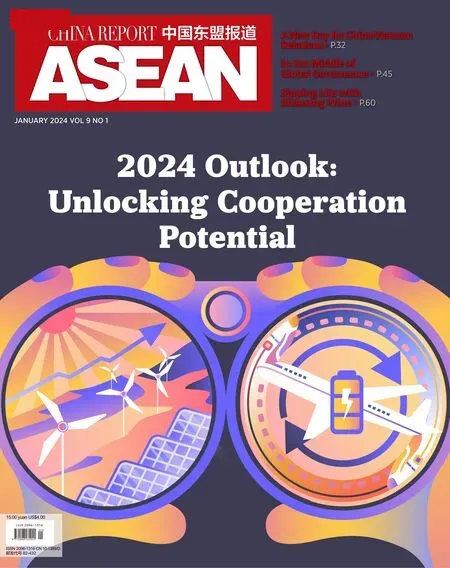China-ASEAN Energy Cooperation
By Gao Yuan
China and ASEAN countries are poised for long-term energy cooperation as complementary needs continue to rise

In October 2023,installation of all photovoltaic modules of the Cirata Floating Solar Power Plant in Indonesia was completed,marking the project officially entering the final phase of commissioning and grid connection.Constructed by PowerChina,the project is the largest floating photovoltaic power station in Southeast Asia and Indonesia’s frist folating photovoltaic power project built by a Chinese enterprise. (POWERCHINA)
China and ASEAN countries achieved successful energy cooperation in 2023.To review the most significant cooperative efforts and development trends of the year and explore future potential of cooperation between China and ASEAN in the energy sector,China Report ASEAN interviewed Huang Yu,director of the Lancang-Mekong National Electric Power Research Institute of China Southern Power Grid(CSG).
China Report ASEAN: What do youconsider the major energy cooperation projects involving China and ASEAN countries in 2023 or undertakings worth long-term attention?
Huang Yu:The year 2023 marked the 10th anniversary of the Belt and Road Initiative and was a bountiful year for energy cooperation between Chinese enterprises and ASEAN countries.The main theme for Chinese energy enterprises “going global” in 2023 has been green development,with numerous breakthroughs in renewable energy project partnerships.In my opinion,the following projects deserve ongoing attention:
First,the 600 MW Monsoon Wind Power Project in Laos undertaken by Power Construction Corporation of China (PowerChina).This project is Laos’ first wind power project and the largest overseas wind power project contracted by a Chinese company.It exemplifies the construction capabilities of Chinese energy companies and their ability to synergize with upstream and downstream industrial chains.
Second,the Upper Stung Tatay Hydropower Station in Cambodia,funded and developed by China National Heavy Machinery Corporation (CHMC).This project has an installed capacity of 150 MW.Having completed its water storage in 2023,the plant,once operational,will provide Cambodia with a stable power supply.Moreover,CHMC has signed a Memorandum of Understanding to develop the 1,000 MW Upper Stung Tatay Pumped Storage Power Station-a key project,and the signing was witnessed by leaders of both countries.It will serve as a critical reserve and regulating power source in Cambodia,laying a foundation for subsequent renewable energy development in the country.

Huang Yu
Third,the Cirata Floating Solar Power Plant in Indonesia undertaken by the PowerChina.This project is the largest floating solar power plant in Southeast Asia,with a total installed capacity of 192 MW.It marks a significant milestone for clean energy technology and energy transformation in Indonesia,creating more opportunities for enhanced cooperation between Chinese and Indonesian companies.
China Report ASEAN: What are the differences and complementary aspects between China and ASEAN countries in terms of energy resources endowment?
Huang:They are quite prominent.
Among the provincial-level regions in southern China,Yunnan stands out for its abundance of hydropower resources,with an exploitable capacity exceeding 100 GW.It also boasts rich coal resources alongside relatively ample wind and solar resources,totaling around 100 GW in developable capacity.While Guangxi’s hydropower resources have largely been utilized,it has a significant exploitable capacity of wind and solar energy resources,totaling 55 GW.Additionally,Guangxi has abundant pumped-storage hydropower sites,making it well-suited for regional energy regulation.
Currently,ASEAN countries rely primarily on fossil fuels such as natural gas,crude oil,and coal,which are largely concentrated in Indonesia,Malaysia,Vietnam,and Thailand.Indonesia has the best crude oil and coal resources in the ASEAN region.In terms of renewable energy,Myanmar,Laos,Vietnam,and Malaysia have relatively abundant hydropower resources,with Myanmar having the greatest potential for hydropower development.Outside Singapore and Brunei,which have relatively limited renewable resources,the rest of the ASEAN countries possess significant development potential in wind and solar resources.
In terms of complementary strengths,China and the ASEAN countries are poised to establish a longterm cooperative pattern in energy supply and demand.Vietnam,Thailand,Cambodia,and southern China will be major areas of net energy demand,while Indonesia,Malaysia,Myanmar,and other countries will be important net suppliers.Moreover,intercomplementarity continues to increase due to differences in the speed of energy transition,variations in renewable energy profiles,and disparities in power system flexibility among countries.
China Report ASEAN: What new progress or outcomes have been achieved in 2023 regarding power interconnection between China and ASEAN countries?What are the plans for 2024?

On March 11,2021,électricité du Laos Transmission Company Ltd.(EDL-T),jointly funded by China Southern Power Grid and électricité du Laos (EDL),signed a concession agreement with the Lao government,marking a substantial step in mutually benefciial cooperation between China and Laos in the feild of power transmission. (PEOPLE’S GOVERNMENT OF XISHUANGBANNA DAI AUTONOMOUS PREFECTURE)

Construction site of the Vinh Tan 1 Coal-fired Power Plant in Vietnam. (LIU GANG)
Huang:The southern region of China borders some ASEAN countries,creating favorable conditions for power interconnection.In 2023,the Electricite du Laos Transmission Company Limited(EDL-T) project,personally endorsed by Chinese President Xi Jinping,largely completed the relevant approval procedures for handover and substantive operation.Jointly funded by CSG and Electricite du Laos (EDL),the project will accelerate construction of a national integrated backbone transmission network under the supervision of the Lao government.Leveraging CSG’s financial strength and proven expertise in grid investment,construction,and management,China aims to provide Laos with safe,reliable,efficient,and sustainable transmission services.This support will contribute to economic growth and elevate public welfare in Laos.The EDL-T project can also promote the sustainable development of Laos’ power grid,the utilization of clean energy,and interconnection with neighboring countries’ power grids.It set a benchmark for comprehensive China-ASEAN power cooperation.These requirements have been included in the Action Plan for Building a China-Laos Community with a Shared Future(2024-2028).In 2024,Chinese energy and power enterprises will continue advancing projects such as the 500 kV China-Laos interconnection project and the renewable energy base in northern Laos.
China will also continue to actively participate in the work of the Regional Power Trading Coordination Committee(RPTCC) and the Regional Energy Transition Work Group within the framework of the Greater Mekong Subregion Economic Cooperation (GMS)to advance regional interconnection cooperation mechanisms.As the Chinese executing agency for power cooperation in the GMS,the CSG is ready to engage in discussions on key issues such as regional grid connectivity,power trade,and green energy transition.
China Report ASEAN: How can China support ASEAN power interconnectionwithin the ten-member bloc?
Huang:Recently,ASEAN countries have progressively proposed key power grid projects to enhance regional connectivity.With distinct advantages in grid construction,China sees potential cooperation opportunities with ASEAN nations in areas such as high-voltage direct current (HVDC) transmission and long-distance power delivery.Cooperation can proceed through collaborative grid construction,with China providing support in engineering technology,electrical equipment,design,and construction.In the long run,main grid reliability will experience higher demand as ASEAN countries strive to advance energy transition and large-scale access to new energy sources.There will be substantial demand for upgrading the power transmission system and regional power interchange.China can maximize the potential of the Lao national power grid project and further broaden the scope of regional power interconnection.There is potential to develop transnational longdistance direct current transmission and flexible grid interconnection.
China Report ASEAN: As the primary investor in ASEAN’s energy sector,how can China support the region’s energy transition with its expertise and experience?
Huang:During the 43rd ASEAN Summit in September 2023,the issuance of a series of documents testified to the commitment of ASEAN member states to collectively address complex and evolving global challenges.Notably,these documents emphasized energy transition as a crucial factor in ASEAN’s transformation into a regional economic growth hub,demonstrating the countries’ commitment to promoting sustainable development.Yet,an energy transition is no small feat.Scaling renewable energy requires a massive injection of capital,while financing shortages and project implementation difficulties have hindered ASEAN.China can support the region by encouraging capital flow into renewable energy.Specifically,China can provide more focused policy support to ASEAN for building power systems designed for large-scale integration of renewable energy through a series of bilateral and multilateral policy dialogues and capacity-building programs.This support includes energy and power planning,market mechanism design,and establishment of relevant technical standards to provide policy and institutional safeguards.Furthermore,China can diversify financing channels for renewable energy projects in ASEAN by strengthening cooperation with domestic and overseas financial institutions.This approach facilitates a more equitable risk-sharing and benefitsharing arrangement with social capital,leveraging additional funds to support Chinese enterprises undertaking renewable energy and power projects in the ASEAN region.
China Report ASEAN: ASEAN countries are placing a strong emphasis on environmental protection in construction of energy projects.What efforts has CSG made to protect the local ecology during the construction of power projects in Southeast Asia? Could you provide an example?
Huang:CSG has consistently upheld the principles of “advanced,reliable,and green” in the development and construction of power projects.Consider the Vinh Tan 1 Coal-fired Power Plant Project in Vietnam as an example.Although it is a conventional power plant,CSG made significant efforts in environmental protection.The project implemented 23 energy-saving and emission-reduction technologies and installed environmental protection facilities such as electrostatic precipitators as well as desulfurization and denitrification units.This approach minimizes pollutant emissions and environmental hazards,reducing carbon dioxide emissions by approximately 20,000 tons annually.The project’s environmental indicators meet or exceed Vietnam’s national standards.With wastewater treated to quality standards before being recycled,the facility became the first project with zero wastewater discharge in Vietnam.Over US$7 million has been invested in optimizing the dredging and sediment disposal plans for dock rehabilitation,mitigating the impact of dredged material on the marine environment.The project’s environmental initiatives have been widely acknowledged by various sectors in Vietnam and extensively covered by the media.Chinese newspaper People’s Daily complimented it as a garden-style power plant that meets Chinese standards.
China Report ASEAN: What potential do you see for energy trade and cooperation between China and ASEAN in the coming years?
Huang:Firstly,it would be essential to promote large-scale renewable energy development,grid integration,and trade within the region to optimize energy resource distribution and facilitate green progress across China and ASEAN.Therefore,energy cooperation between China and ASEAN in the coming years will continue to prioritize renewable energy development,support power infrastructure,and promote grid interconnection.Future efforts can be made to continuously strengthen the construction of Laos’ transmission grid,promote diversified power supplies,and empower greater interconnection,building a real “Southeast Asia’s battery.”Secondly,in areas where renewable energy development is on a smaller scale and grid support is insufficient,it is important to consider planning and deploying distributed new energy sources to meet local low/zero-carbon demand through integrated approaches.These integrated energy development schemes aim to increase access to electricity,decrease the population in areas without electricity,and drive overall economic growth across the region.State-owned enterprises,when promoting energy cooperation with ASEAN countries,can actively involve upstream and downstream industry chain partners to jointly “go global”,creating a brand effect of “Chinese Quality,Chinese Standards” in the energy sector.

